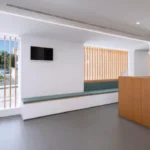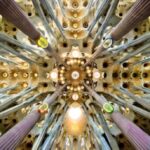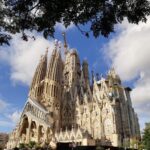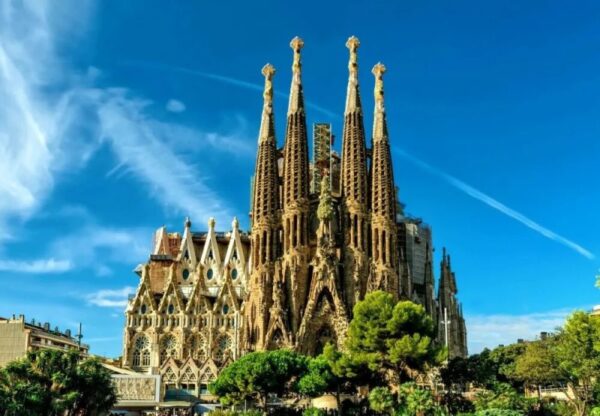
- Exploring the Architectural Wonders of the Sagrada Familia in Barcelona
- The Fascinating History Behind the Sagrada Familia Temple
- Understanding the Symbolism of the Sagrada Familia's Design and Features
- Visitor's Guide: How to Experience the Sagrada Familia in Barcelona
- The Impact of Antoni Gaudí on Modern Architecture Through the Sagrada Familia
- Why the Sagrada Familia is a Must-See UNESCO World Heritage Site
The Sagrada Familia, designed by the visionary architect Antoni Gaudí, stands as an iconic symbol of Barcelona's rich cultural heritage. Its intricate details and towering spires captivate millions of visitors each year, drawing admiration for both its artistic beauty and architectural innovation.
Known as The Majestic Temple of Sagrada Familia in Barcelona, this basilica has been under construction since 1882, embodying a unique blend of Gothic and Art Nouveau styles. As it nears completion, the temple continues to inspire awe and reflection, making it a true masterpiece of modern architecture.
Exploring the Architectural Wonders of the Sagrada Familia in Barcelona
Exploring the architectural wonders of the Sagrada Familia reveals a tapestry of innovative design that reflects Antoni Gaudí's genius. The basilica's façade is adorned with intricate sculptures that depict various biblical scenes, immersing visitors in a narrative journey of faith and creativity. The use of natural forms in the columns and façades echoes Gaudí's deep appreciation for nature, making the structure not just a place of worship but a living testament to the environment.
One of the most remarkable aspects of the Sagrada Familia is its unique structural system, which employs a combination of hyperboloids and paraboloids. These shapes not only enhance the building's aesthetic appeal but also improve its stability and strength. As visitors explore the interior, they are greeted by
- Vibrant stained glass windows that flood the space with colorful light
- A forest of columns that mimic tree trunks, creating a sense of being in a natural setting
- The intricate play of shadows and light that changes throughout the day
, all contributing to a truly immersive experience.
In addition to its aesthetic qualities, the Sagrada Familia showcases Gaudí's groundbreaking use of materials and techniques. The ongoing construction utilizes eco-friendly practices, ensuring that this architectural wonder remains relevant in the context of contemporary sustainability. Each stone laid is a piece of history in the making, as the temple evolves into a harmonious blend of the past and future.
For those interested in the technical aspects, a comparison of Gaudí's design principles with traditional architectural methods highlights his innovative approach. The following table illustrates key differences:
| Traditional Architecture | Gaudí's Approach |
|---|---|
| Symmetrical designs | Asymmetrical forms |
| Rigid materials | Natural materials |
| Linear structures | Curvilinear forms |
Ultimately, exploring the architectural wonders of the Sagrada Familia is not just about appreciating its beauty; it's about understanding the profound vision behind its creation and the legacy that continues to inspire future generations.
The Fascinating History Behind the Sagrada Familia Temple
The history of the Sagrada Familia is as captivating as its architecture, beginning in 1882 when construction first commenced under architect Francisco de Paula del Villar. However, it was the arrival of Antoni Gaudí in 1883 that transformed the project into a visionary masterpiece, as he dedicated his life to bringing this iconic basilica to fruition. Gaudí's unique style infused the structure with an organic essence, reflecting his belief that architecture should be in harmony with nature.
Despite its ongoing construction, the Sagrada Familia has endured numerous challenges throughout its history, including the Spanish Civil War in the 1930s, which resulted in the destruction of many of Gaudí's original plans and models. However, a committed team of architects and craftsmen has worked tirelessly to reconstruct and complete the designs based on Gaudí's concepts, ensuring that his vision lives on.
Today, the Sagrada Familia is not only an architectural feat but also a symbol of resilience and dedication. As it nears completion, anticipated in 2026 for the centenary of Gaudí's death, the temple attracts millions of visitors worldwide, eager to witness its breathtaking beauty and hear the stories of its fascinating history. This temple embodies the spirit of Barcelona and stands as a testament to the city’s cultural identity.
Furthermore, the Sagrada Familia is a UNESCO World Heritage site, recognized for its outstanding universal value. Its intricate facades and stunning interiors represent a synthesis of artistic styles and religious symbolism, making it a unique example of modernist architecture. As such, it continues to inspire not only architects but also artists, historians, and visitors who come to experience its profound beauty and rich history.
Understanding the Symbolism of the Sagrada Familia's Design and Features
The Sagrada Familia is not just a breathtaking piece of architecture; it is a profound expression of spiritual symbolism. Each element of its design carries a deeper meaning, reflecting the fusion of faith and artistry. The towering spires, representing the twelve apostles, stand as a testament to the Christian faith, while the intricate sculptures on the façades narrate key biblical stories, inviting visitors to engage with the narrative of salvation.
Gaudí's use of natural forms extends beyond aesthetics; it symbolizes the connection between the divine and the natural world. For instance, the columns resembling tree trunks are designed to create a forest-like interior, evoking a sense of serenity and wonder. This immersive experience serves to remind worshippers of the beauty of creation, emphasizing the importance of nature in spiritual contemplation.
Additionally, the color and light play a crucial role in the temple's atmosphere. The vibrant stained glass windows are strategically placed to ensure that different times of the day cast varying hues across the interior. This dynamic interplay of light not only enhances the visual experience but also symbolizes the divine presence, creating an environment conducive to reflection and prayer.
To delve deeper into the symbolism, consider the following elements:
- Façade of the Nativity: Represents the birth of Jesus, filled with joyful and lively sculptures.
- Passion Façade: Illustrates the suffering and sacrifice of Christ, marked by stark, angular designs.
- Glory Façade: Portrays the resurrection and represents the heavenly glory awaiting believers.
Visitor's Guide: How to Experience the Sagrada Familia in Barcelona
When visiting the Sagrada Familia, planning ahead can greatly enhance your experience. Start by purchasing your tickets online to avoid long queues, especially during peak tourist seasons. Opt for a guided tour to gain deeper insights into the architectural wonders and the life of Antoni Gaudí, ensuring you don’t miss any significant details of this majestic temple.
Arriving early in the day allows you to enjoy a quieter atmosphere, which is perfect for appreciating the stunning stained glass windows as sunlight pours through. Take your time to explore the different areas of the basilica, from the awe-inspiring Nativity Façade to the dramatic Passion Façade. Each section tells its own story, reflecting Gaudí's unique vision and dedication.
During your visit, consider taking a moment to climb one of the towers for panoramic views of Barcelona. This offers a unique perspective on the basilica's intricate design from above, as well as a chance to see the vibrant city skyline. Don't forget to bring a camera to capture the breathtaking sights!
Lastly, after your exploration, take some time to relax in the nearby park. The surrounding gardens provide a peaceful setting to reflect on your experience. You can also find various informational plaques detailing the ongoing construction and Gaudí's legacy, enriching your understanding of this extraordinary site.
The Impact of Antoni Gaudí on Modern Architecture Through the Sagrada Familia
Antoni Gaudí's impact on modern architecture is profoundly encapsulated in the Sagrada Familia, where his pioneering vision reshaped architectural norms. By integrating natural forms and organic shapes into the design, Gaudí moved away from conventional straight lines, creating a fluidity that has influenced countless architects. His ability to merge structural integrity with aesthetic beauty laid the groundwork for a new architectural language that values both function and art.
Moreover, Gaudí's innovative use of geometry in the Sagrada Familia is a testament to his forward-thinking approach. The combination of hyperbolic and parabolic forms not only enhances the temple's beauty but also provides significant structural benefits. This groundbreaking approach to geometry has inspired contemporary architects to explore unconventional forms, pushing the boundaries of design and engineering.
Incorporating sustainability into his designs, Gaudí anticipated modern eco-friendly practices. The ongoing construction of the Sagrada Familia employs techniques that minimize environmental impact, reflecting a commitment to sustainability that resonates with today's architectural ethos. This foresight has positioned the Sagrada Familia as a beacon of modern architecture, demonstrating that buildings can harmonize with their surroundings while also addressing contemporary environmental concerns.
Ultimately, the legacy of Gaudí is evident in the Sagrada Familia's influence on modern architecture. His visionary ideas have fostered a new generation of architects who draw inspiration from his works, ensuring that his innovative spirit continues to shape the architectural landscape. As the Sagrada Familia approaches completion, it stands not only as a masterpiece of design but also as a symbol of the evolution of architecture itself.
Why the Sagrada Familia is a Must-See UNESCO World Heritage Site
Visiting the Sagrada Familia is an unparalleled experience that extends beyond mere admiration of its architectural beauty. As a UNESCO World Heritage Site, it represents a vital piece of cultural heritage that showcases the extraordinary vision of Antoni Gaudí. The basilica's intricate designs and rich symbolism offer visitors a profound understanding of the intersection between art and spirituality, making it a must-see for anyone traveling to Barcelona.
One key reason to visit the Sagrada Familia is its unique architectural style, which harmonizes elements of Gothic and Art Nouveau. Visitors can experience:
- Intricate façades that tell biblical stories
- A stunning interior that mimics a natural forest with its tree-like columns
- Vibrant stained glass that transforms light into a meditative atmosphere
This seamless blend of styles and themes allows for a deeply immersive journey into the heart of Gaudí's genius.
Moreover, the Sagrada Familia serves as a canvas for ongoing architectural innovation. As construction continues, the project utilizes cutting-edge techniques and eco-friendly practices that reflect a commitment to sustainability. This dynamic evolution not only preserves Gaudí's original vision but also adapts to contemporary needs, ensuring that the basilica remains relevant in today's world.
Finally, the impact of the Sagrada Familia extends beyond its walls. It captivates and inspires artists, architects, and visitors alike, making it a focal point for discussions about modernism and cultural heritage. By witnessing this architectural marvel, visitors contribute to a legacy that honors both the past and the future of art and architecture.
 Discover Exceptional Dental Care at Uros Associats Clinic near Sagrada Família, Barcelona | 94
Discover Exceptional Dental Care at Uros Associats Clinic near Sagrada Família, Barcelona | 94 Western Union Agency near Sagrada Familia in Barcelona | '94
Western Union Agency near Sagrada Familia in Barcelona | '94 Exploring Urology Services at Sagrada Familia Clinic in Barcelona
Exploring Urology Services at Sagrada Familia Clinic in Barcelona Sagrada Familia Barcelona: What Is It and Why You Must Visit
Sagrada Familia Barcelona: What Is It and Why You Must VisitIf you want to know other articles similar to The Majestic Temple of Sagrada Familia in Barcelona you can visit the category WHERE YOU CAN GO.
Deja una respuesta










Read more!